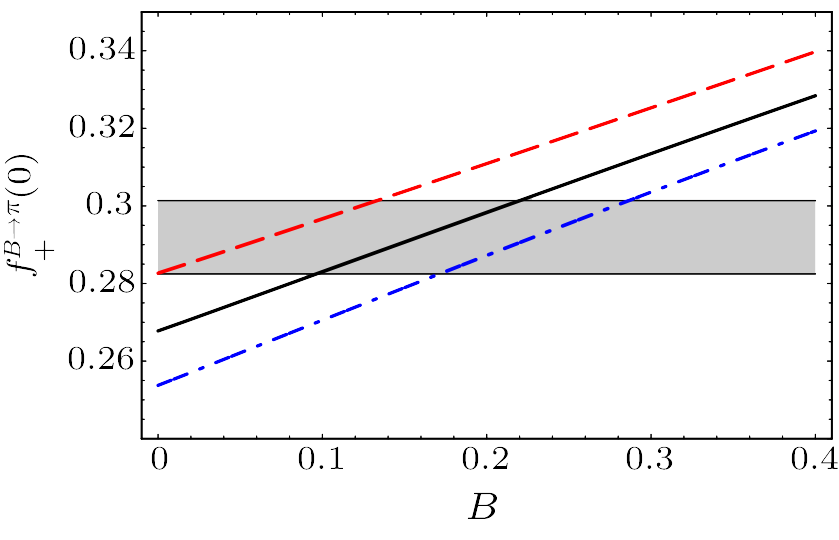| THE PHYSICS OF ELEMENTARY PARTICLES AND FIELDS |
 |
|

|
|
|
Finding a Way to Determine the Pion Distribution Amplitude from the Experimental Data |
| HUANG Tao1, WU Xing-Gang2, ZHONG Tao1 |
1Institute of High Energy Physics and Theoretical Physics Center for Science Facilities, Chinese Academy of Sciences, Beijing 100049
2Department of Physics, Chongqing University, Chongqing 401331 |
|
| Cite this article: |
|
HUANG Tao, WU Xing-Gang, ZHONG Tao 2013 Chin. Phys. Lett. 30 041201 |
|
|
|
|
Abstract It is believed that one can extract more accurate information of the pion distribution amplitude from the pion-photon transition form factor (TFF) due to the single pion in this process. However, the BABAR and Belle data of the pion-photon TFF have a big difference for Q2∈[15,40] GeV2, and at present, the pion DA can not be definitely determined from the pion-photon TFF. It is crucial to find the right pion DA behavior and to determine which data is more reliable. We perform a combined analysis of the most existing data of the processes involving pion by using a general model for the pion wavefunction/DA. Such a DA model can mimic all the existed pion DA behaviors, whose parameters can be fixed by the constraints from the processes π0→γγ, π→μν, and B→πl ν, etc. Especially, we examine the B →π transition form factors that provides another constraint to the parameter B in our DA model, which results in B∈[0.00,0.29]. This inversely shows that the predicted curve for the pion-photon TFF is between the BABAR and Belle data in the region Q2∈[15,40] GeV2. It will be tested by coming more accurate data in large Q2 region, and the definite behavior of pion DA can be concluded finally.
|
|
Received: 11 March 2013
Published: 28 April 2013

|
|
|
|
|
|
|
|
[1] Uehara S et al arXiv:1205.3249v2[hep-ex]
[2] Aubert B et al 2009 Phys. Rev. D 80 052002
[3] Beringer J et al 2012 Phys. Rev. D 86 010001
[4] Wu X G and Huang T 2010 Phys. Rev. D 82 034024
[5] Wu X G and Huang T 2011 Phys. Rev. D 84 074011
[6] Huang T, Ma B Q and Shen Q X 1994 Phys. Rev. D 49 1490
[7] Cao F G and Huang T 1999 Phys. Rev. D 59 093004
[8] Huang T, Wu X G and Wu X H 2004 Phys. Rev. D 70 053007
[9] Huang T and Wu X G 2004 Phys. Rev. D 70 093013
[10] Huang T and Wu X G 2007 Int. J. Mod. Phys. A 22 3065
[11] Brodsky S J, Huang T and Lepage G P 1983 Proc. Banff Summer Inst. (NewYork: Plenum) p 143
[12] Huang T 1981 Proc. XXth Int. Conf. High Energy Phys. (New York: AIP) p 1000
[13] Melosh H J 1974 Phys. Rev. D 9 1095
[14] Lepage G P and Brodsky S J 1980 Phys. Rev. D 22 2157
[15] Wu X G, Huang T and Zhong T 2012 arXiv:1206.0466v2[hep-ph]
[16] Huang T and Wu X G 2005 Phys. Rev. D 71 034018
[17] Belyaev V M, Braun V M, Khodjamirian A and Rückl A 1995 Phys. Rev. D 51 6177
[18] Ball P 1998 J. High Energy Phys. 09 005
[19] Ball P and Zwicky R 2005 Phys. Rev. D 71 014015
[20] Ball P and Zwicky R 2001 J. High Energy Phys. 10 019
[21] Duplancic G, Khodjamirian A, Mannel T and Melic B 2008 J. High Energy Phys. 04 014
[22] Huang T, Li Z H and Wu X Y 2001 Phys. Rev. D 63 094001
[23] Wang Z G, Zhou M Z and Huang T 2003 Phys. Rev. D 67 094006
[24] Huang T, Li Z H, Wu X G and Zuo F 2008 Int. J. Mod. Phys. A 23 3237
[25] Wu X G and Huang T 2009 Phys. Rev. D 79 034013
[26] Li Z H, Zhu N, Fan X J and Huang T 2012 J. High Energy Phys. 2012 160
[27] Zhou M Z, Wu X H and Huang T 2004 High Energy Phys. Nucl. Phys. 28 927
[28] Zhong T, Wu X G, Zhang J W, Tang Y Q and Fang Z Y 2011 Phys. Rev. D 83 036002
[29] Sanchez P et al 2011 Phys. Rev. D 83 052011
[30] Bailey J A et al 2009 Phys. Rev. D 79 054507
[31] Debbio L D, Flynn J M, Lellouch L and Nieves J 1998 Phys. Lett. B 416 392
[32] Kuhn J H, Steinhauser M and Sturm C 2007 Nucl. Phys. B 778 192
[33] Brodsky S J and Teramond G F 2008 arXiv:0802.0514v1[hep-ph]
[34] Behrend H J et al 1991 Z. Phys. C 49 401
[35] Savinov V et al 1997 arXiv:hep-ex/9707028v1
[36] Gronberg J et al 1998 Phys. Rev. D 57 33
[37] Huang T and Wu X G 2007 Eur. Phys. J. C 50 771
[38] Brodsky S J, Cao F G and Teramond G F 2011 Phys. Rev. D 84 033001
[39] Brodsky S J, Cao F G and Teramond G F 2011 Phys. Rev. D 84 075012 |
|
Viewed |
|
|
|
Full text
|
|
|
|
|
Abstract
|
|
|
|
|